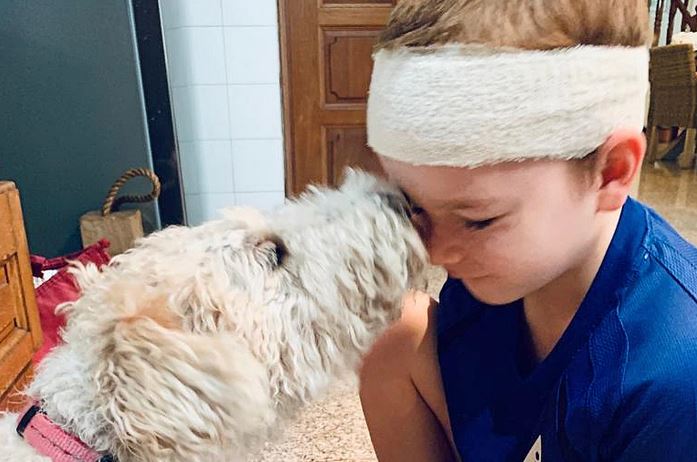7-Year-Old Battles Melanoma – But He Didn’t Get it From the Sun
At just 7 years old, a seemingly healthy Hayden Price was diagnosed with melanoma.
Liza Price, Hayden’s mother, said the news came as a surprise. “What shocked us was the Hayden that we were seeing was his happy, healthy self … we were very, very shocked.”
Now, Hayden’s parents want to encourage others to be aware of the dangerous skin cancer and regularly check their skin for any new marks.
Hayden first started complaining about what was thought to be a skin tag on the back of his head that became irritated every time he put on a helmet, hat, or goggles.
“He had it removed and we actually thought that that was going to be the end of the story,” Liza said. “But the plastic surgeon called us and said, “I’m really sorry to tell you this, but it’s come back as melanoma.”
Liza said that “everyone was taken aback” by the diagnosis, including the surgeon who called the pathology laboratory to reconfirm the results.
“We just didn’t think that children as young as Hayden could get melanoma,” she said. “Nathan and I would hold it together all day and fall apart at night time,” she added.
The devastated couple had to break the news to their other two children, ages 10 and 11.
“We told the kids that Hayden had a little something removed from the back of his head,” Liza said. “My older son had shaved his head in support of Hayden. He said, ‘Mum, all my friends think I’m really cool shaving my head but they think that I’m doing it because Hayden has cancer,’ and that’s when I thought I can’t keep protecting them from the truth. So I said, ‘I don’t want to scare you, but Hayden does actually have a type of cancer’.”
Tests revealed that Hayden had a rare subtype of melanoma that was not caused by sun exposure.
The cancer spread to his lymph nodes and he underwent a seven-hour surgery in July last year — a day after his eighth birthday — to remove the melanoma.
A skin graft from his groin replaced skin at the “significant” wound site on the back of his head. “The surgeon did warn us that it was going to be quite confronting,” Liza said.
“But … his main concern was making sure that he removed all traces of cancer from that area, which of course was our priority too. We feel very fortunate to be in the hands of the excellent doctors here in Singapore throughout this ordeal.”
The family was temporarily living in Singapore and is due to return to their home in Australia later this year.
Singaporean specialists and oncologist Georgina Long from the Melanoma Institute of Australia (MIA) decided that immunotherapy would be a suitable treatment for Hayden.
It works by harnessing the body’s own immune system to fight the cancer cells.
Richard Scolyer of the MIA is the world’s leading melanoma pathologist. He initially confirmed Hayden’s extremely rare diagnosis.
“I was a little surprised,” Professor Scolyer said. “In Australia, there are 15,000 patients diagnosed with melanoma each year. In children [aged] less than 10 [there are] … fewer than 20 [cases] a year.”
Professor Scolyer said that there are three subtypes of melanoma in children and the one that Hayden has is considered the rarest.
“The Braf-mutant melanoma is a melanoma that’s developed in association with a mole that’s developed during the course of the patient’s life,” he said.
Over the past 10 years, Professor Scolyer said treatments for melanoma had become more successful. “We had no effective therapies for patients whose melanoma had spread,” he said.
“Through the work that our team at MIA has led … immunotherapy has now become a standard treatment for patients who previously didn’t have hope.”
Professor Scolyer explained that MIA played a leading role globally in immunotherapy research for treating melanoma. “In fact, what we’ve discovered in melanoma is now being used to treat other cancers,” he said.
Georgina Long describes it as the penicillin moment for cancer therapy. “It’s only due to the support for research that breakthroughs like new treatments like immunotherapy become available.”
Ms Price described the treatment as “revolutionary”.
It is administered through a port in Hayden’s chest every three weeks for nearly a year.
“Our doctors tell us how lucky we are that that has happened now and not five or 10 years ago because this sort of treatment just wasn’t available,” she said.
“That’s actually why Nathan and I have shared Hayden’s story because we’re passionate about making sure the Melanoma Institute of Australia is funded to its capacity. Research actually saves lives and it’s saving our little Hayden right now.”
Hayden’s love for “quirky”, odd clothing inspired the Price family to start a fundraising initiative, Odd Sock Day, that has been embraced in three countries so far.
“Hayden actually loves to mix up his clothing,” Liza said. “He’ll often wear T-shirts inside out and back to front, his shorts back to front. For years, he wore his shoes on the wrong feet.”
The MIA embraced the Price family’s idea and adopted the hashtag #OddSocksForHayden to inspire others to have their own fundraiser.
“It’s everybody’s contribution that adds up to a bigger result,” she said.
“Odd Sock Day can be rolled out at your school or workplace into April so we really hope that as many schools and offices and sporting clubs take it on board.”








Is anyone here in a position to recommend Slogan T-Shirts? Thanks xxx